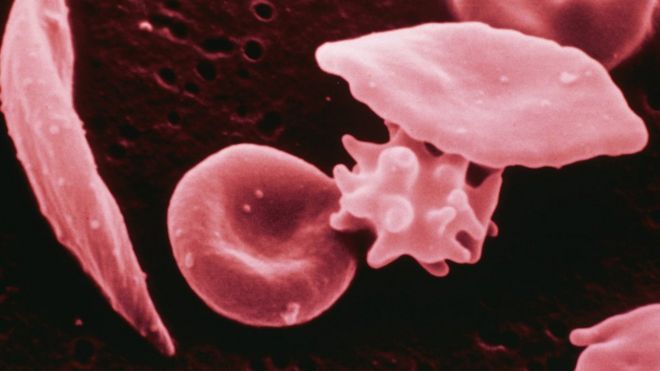BBC news reports that a Paris teenager with Sickle cell disease, treated by genetic manipulation (using a virus) seems to be okay and well two years later.
Is this a possible cure?
 |
| Healthy red blood cells are round, but the genetic defect makes them sickle shaped, Photo credit: SPL. |
Hydroxyurea, which stimulates fetal hemoglobin production, is the only disease-modifying therapy for SCD; allogeneic hematopoietic stem cell transplant is curative. Fewer than 18% of people with severe SCD find transplant matches. For them, autologous transplant with a corrected beta globin gene — gene therapy — is a tantalizing chance at a possibly one-time treatment.
Jean-Antoine Ribeil, MD, PhD, from the Reference Centre for Sickle Cell Disease, Necker Children's Hospital, Paris, France, and colleagues introduced a lentiviral vector bearing an antisickling variant of HbA into a boy when he was 13 years old. The patient "had complete clinical remission with correction of hemolysis and biologic hallmarks of the disease," they write.
in plain English, when the body is stressed, the red blood cells change shape to a "C"... these cells then can't get through the small tiny blood vessels. Then the low oxygen in the areas where they clog up circulation gets lower in oxygen, causing more and more cells to change shape and block circulation.
Hydroyurea cuts down this as does aggressive treatment of infections (antibiotics) and stopping dehydration when sick.
Several cures have been proposed: Bone marrow transplants of the stem cells that make blood would work, but it has a lot of risks/side effects, and you need a good donor match.
This treatmen uses a virus to snip in a new piece of DNA to fix the problem.
Gizmodo has a ong article here about possible treatments.
Sickle cell disease affects about 100,000 people in the US, most of whom are black. It is an inherited genetic disease caused by a mutation of a single letter in a person’s genetic code.
This single-letter mutation makes it a promising candidate for cutting edge technologies, like the gene-editing technique CRISPR-Cas9, and other gene therapies. Recently, a rush of new research has sought to address it. Two other gene therapy studies for sickle cell are underway in the US —one at UCLA and another at Cincinnati Children’s Hospital. Yet another is about to start in a collaboration between Harvard and Boston Children’s Hospital. Last fall, researchers all demonstrated the ability to correct the mutation in human cells using CRISPR, though that strategy will yet have to surpass significant scientific and political hurdles before reaching clinical trials.
In the new study, researchers took bone marrow stem cells from the boy and fed them corrected versions of a gene that codes for beta-globin, a protein that helps produce normal hemoglobin. The hope was that those altered stem cells would interfere with the boy’s faulty proteins and allow his red blood cells to function normally. They continued the transfusions until the transplanted cells began to produce normal-shaped hemoglobin. In the following months, the numbers of those cells continued to increase until in December 2016, they accounted for more than half the red blood cells in his body. In other words, so far so good.
No comments:
Post a Comment